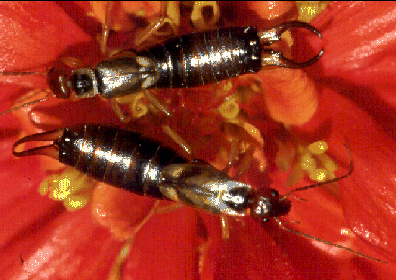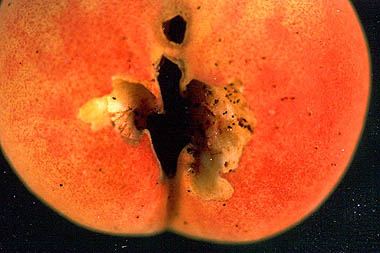European Earwig
General Description
The European earwig can be beneficial as well as a pest. Adults and nymphs can damage fruits. They will feed on over-ripe or split peaches and apricots.
Although the European earwig (Fig. 1) is an important predator of some pests, it can cause damage to soft fruit, particularly peaches and apricots by chewing into ripening and overripe fruit (Fig. 2).
 |
 |
| Figure 1. European earwigs. | Figure 2. Earwig feeding damage to apricot. |
Any feeding damage increases the risk of brown rot infections by wind or water-borne spores and possibly by transfer of spores as they and other insects feed, Earwigs also hide in bagged apples where they feed upon fruit damaged by bud moth and leafroller larvae. They feed at night, and during the day hide in cracks and crevices and under leaves and twigs next to fruit.
Rolled or crumpled newspaper tucked into limb crotches, or wrapping trunks or scaffold limbs with corrugated cardboard, are useful ways to monitor for earwigs. Place plastic bags or wrap over the newspaper and cardbaord bands to keep them dry. Removal of debris and weed growth from the base of trees will aid in reducing earwig numbers.
Success and Entrust are toxic to earwigs. To keep earwigs out of trees, wrap a smooth part of the trunk with a 10-15 cm-wide strip of duct tape or other plastic wrap and apply a 3-5 cm-wide band of Tanglefoot or Stickum around the tape. Apply this barrier before earwigs become active in the spring. Also place small boxes or cans filled with crumpled newspaper or rolls of newspaper or cardboard on the ground to capture earwigs for disposal.
Hosts
Aphids, mites, pear psylla, insect eggs (including codling moth eggs)
Damage
Identification
Egg - Small, oval, pearly white.
Larva - Looks like adult, lack wings.
Adult - Brownish black, 14.0 mm long, short feathery front wings, pair of forceps at rear (Fig. 1).
.jpg) |
| Figure 1. Male European earwig. (AA-FC) |
Life History
Overwinter as adults. Females lay eggs in spring and care for the nymphs for 1-2 weeks. One generation per year.
Monitoring
Earwigs are nocturnal, feed at night and hide during the day. Traps made from crumpled paper in tubes or cans, rolled cardboard can be used to detect their presence and to collect individuals. Limb taps can also be used to monitor their presence.
